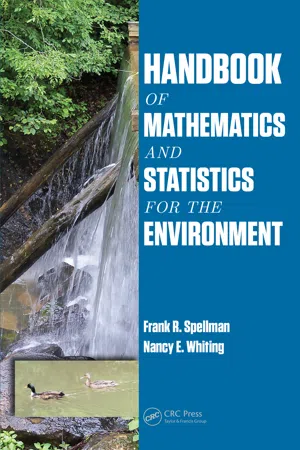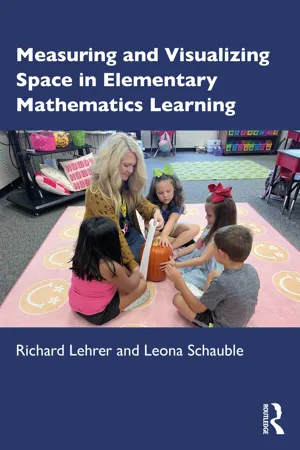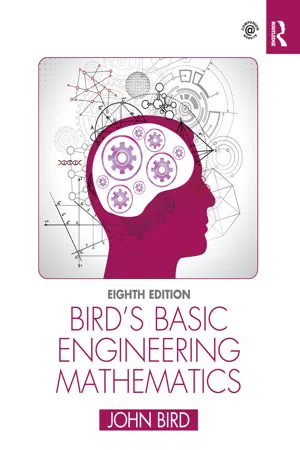Mathematics
Area and Volume
Area refers to the measure of the surface enclosed by a shape, such as a square or circle, and is typically expressed in square units. Volume, on the other hand, refers to the measure of the space occupied by a three-dimensional object, such as a cube or sphere, and is typically expressed in cubic units. Both area and volume are fundamental concepts in geometry and calculus.
Written by Perlego with AI-assistance
Related key terms
1 of 5
8 Key excerpts on "Area and Volume"
- eBook - PDF
- John Peterson, Robert Smith(Authors)
- 2019(Publication Date)
- Cengage Learning EMEA(Publisher)
437 Geometric Figures: Areas and Volumes 6 OBJECTIVES After studying this unit you should be able to ● ● Express given customary area measures in larger and smaller units. ● ● Express given metric area measures in larger and smaller units. ● ● Convert between customary area measures and metric area measures. ● ● Compute areas, lengths, and widths of rectangles. ● ● Compute areas, bases, and heights of parallelograms. ● ● Compute areas, both bases, and heights of trapezoids. ● ● Compute areas of more complex figures (composite figures) that consist of two or more common polygons. As previously stated, in machine technology linear or length measure is used more often than Area and Volume measure. However, the ability to compute areas and volumes is required in determining job-material quantities and costs. Often, before a product is manufactured, part weights are computed. Volumes of simple geometric figures and combinations of figures (composite figures) must be calculated before weights can be determined. Section 6 presents Area and Volume measure of two-dimensional and three-dimensional geometric figures and practical Area and Volume applications. Areas of Rectangles, Parallelograms, and Trapezoids UNIT 59 CUSTOMARY AND METRIC UNITS OF SURFACE MEASURE (AREA) A surface is measured by determining the number of surface units contained in it. A surface is two dimensional. It has a length and width, but no thickness. Both length and width must be expressed in the same unit of measure. Area is computed as the SECTION SIX 438 SECTION 6 GEOMETRIC FIGURES: AREAS AND VOLUMES product of two linear measures and is expressed in square units. For example, 2 inches 3 4 inches 5 8 square inches (8 sq in. or 8 in. 2 ). The surface enclosed by a square that is 1 inch on a side is 1 square inch (1 sq in. or 1 in. 2 ). The surface enclosed by a square that is 1 foot on a side is 1 square foot (1 sq ft or 1 ft 2 ). - Frank R. Spellman, Nancy E. Whiting(Authors)
- 2013(Publication Date)
- CRC Press(Publisher)
Sphere— A container shaped like a ball. Square units— Measurements used to express area (e.g., square feet, square meters, acres). Volume— The capacity of a unit (how much it will hold), measured in cubic units (e.g., cubic feet, cubic meters) or in liquid volume units (e.g., gallons, liters, million gallons). Width— The distance from one side of the tank to the other, measured in linear units. 61 Basic Math Operations 2.11.2 R ELEVANT G EOMETRIC E QUATIONS Circumference C of a circle: C = π d = 2 π r Perimeter P of a square with side a : P = 4 a Perimeter P of a rectangle with sides a and b : P = 2 a + 2 b Perimeter P of a triangle with sides a , b , and c : P = a + b + c Area A of a circle with radius r ( d = 2 r ): A = π d 2 /4 = π r 2 Area A of duct in square feet when d is in inches: A = 0.005454 d 2 Area A of a triangle with base b and height h : A = 0.5 bh Area A of a square with sides a : A = a 2 Area A of a rectangle with sides a and b : A = ab Area A of an ellipse with major axis a and minor axis b : A = π ab Area A of a trapezoid with parallel sides a and b and height h : A = 0.5( a + b ) h Area A of a duct in square feet when d is in inches: A = π d 2 /576 = 0.005454 d 2 Volume V of a sphere with a radius r ( d = 2 r ): V = 1.33 π r 3 = 0.1667 π d 3 Volume V of a cube with sides a : V = a 3 Volume V of a rectangular solid (sides a and b and height c ): V = abc Volume V of a cylinder with a radius r and height H : V = π r 2 h = π d 2 h /4 Volume V of a pyramid: V = 0.33 2.11.3 G EOMETRICAL C ALCULATIONS 2.11.3.1 Perimeter and Circumference On occasion, it may be necessary to determine the distance around grounds or landscapes. To mea-sure the distance around property, buildings, and basin-like structures, it is necessary to determine either perimeter or circumference. The perimeter is the distance around an object; a border or outer boundary. Circumference is the distance around a circle or circular object, such as a clarifier.- eBook - PDF
- Alberto D. Yazon(Author)
- 2019(Publication Date)
- Society Publishing(Publisher)
This chapter further explains the basic differences between area and perimeter. 4.2. DEFINITION OF AREA In the mensuration sector of mathematics, the area of a flat surface is being defined as the amount of space being covered by it. It is a physical quantity that indicates the number of square units being occupied by the two-dimensional object or a two-dimensional shape. It is being employed to know how much space is taken up by a flat surface. It is being measured in square units, such as square meters, square miles, square inches, etc. (Figure 4.2). Figure 4.2: Definition of area. Source: https://upload.wikimedia.org/wikipedia/commons/thumb/b/b9/Area. svg/1024px-Area.svg.png. The term area has various practical usages such as construction schemes, agriculture, architecture, and so on. To measure the area of a flat surface, one needs to count the number of squares being covered by the shape. Introduction to Mathematical Literacy 76 The area is the amount of two-dimensional space being taken up by the object. It is usually being measured in square units. As an example: Suppose if any individual person required tiling the floor of the room, the number of tiles needed to cover the complete room will be its area. 4.3. DEFINITION OF PERIMETER The perimeter is being explained as a measure of the length of the outline that surrounds a closed geometrical figure. The general term ‘perimeter’ is basically coming from the Greek word, ‘Peri’ and ‘meter’ which roughly translates to ‘around’ and ‘measure.’ In the field of geometry, it basically implies the continuous line creating the path outside the two-dimensional shape. The perimeter is the length all around the outside of a polygon or the course that encircles an area. This is different from the surface area. The surface area is how much surface is being encompassed by the polygon or space (Figure 4.3). Figure 4.3: Definition of the perimeter. Source: https://upload.wikimedia.org/wikipedia/commons/9/9b/Wet_perim-eter.PNG. - Richard Lehrer, Leona Schauble(Authors)
- 2023(Publication Date)
- Routledge(Publisher)
Students also begin to reason about structures that are not rectilinear, such as the volumes of cylinders, which can also be imagined as created by sweeping the base through the height. Students are sometimes surprised to discover that “unwrapping” the cylinder produces a rectangle that corresponds to the body of the cylinder (with dimensions equal to the circumference of the cylinder and its height). The area of this rectangle, plus the area of the two bases, constitutes the total surface area of the cylinder.As the preceding examples illustrate, volume measurement both builds from and is consistently linked to understanding of area measure. The same principles of units (e.g., consistent units, tiling) are germane to measuring both Area and Volume. The dynamic metaphor of an area pulled through its base repeatedly reinforces both distinctions and connections between Area and Volume during instruction. There is good evidence that even much older students struggle to differentiate surface area from volume of polygons (e.g., Chiphambo & Mtsi, 2021 ), suggesting the value of (1) framing contexts that ground this differentiation to concrete meaning and (2) repeatedly articulating the conceptual and mathematical relationships between Area and Volume.References
- Barrett, J ., Clements, D. H., & Sarama, J. (2017). Children’s measurement: A longitudinal study of children’s knowledge and learning of length, area, and volume . Journal for Research in Mathematics Education Monograph Series (Vol. 16 ). Reston, VA: National Council of Teachers of Mathematics.
- Battista, M. T . (1990). Understanding students’ thinking about Area and Volume measurement . In D. H. Clements & G. Bright (Eds.), Learning and teaching measurement: 2003 yearbook (pp. 122–142). Reston, VA: National Council of Teachers of Mathematics.
- Battista, M. T . (1999). Fifth graders’ enumeration of cubes in 3D arrays: Conceptual progress in an inquiry classroom . Journal for Research in Mathematics Education , 30(4 ), 417–446.
- Battista, M. T . (2004). Applying cognition-based assessment to elementary school students’ development of understanding of Area and Volume measurement
- eBook - ePub
Learning and Teaching Early Math
The Learning Trajectories Approach
- Douglas H. Clements, Julie Sarama(Authors)
- 2020(Publication Date)
- Routledge(Publisher)
11 Geometric Measurement1Area, Volume, and Angle
I had a student who basically understood the difference between area and perimeter. I drew this rectangle on a grid. To figure the area, she counted down like this (Figure 11.1a ), then she counted across like this (Figure 11.1b ). Then she multiplied 3 times 4 and got 12. So, I asked her what the perimeter was. She said it was “the squares around the outside.” She counted like this (Figure 11.1c ). She understood the perimeter, she just counted wrong. She was always off by 4.Do you agree with this teacher? Does the student understand area and perimeter and distinguish between them? What would you have asked the student to find out for sure?Figure 11.1 A student works with a perimeter problemArea Measurement
Area is an amount of two-dimensional surface that is contained within a boundary. Area is complex, and children develop area concepts over time. Sensitivity to area is present in the first year of life, as is sensitivity to number. However, infants’ approximate number sense is more accurate than their corresponding sense of area. So, even infants find area challenging!Area understandings do not develop well in typical U.S. instruction and have not for a long time. Young children show little explicit understanding of measurement. Primary graders, asked how much space a square would cover, used a ruler (once) to measure. Even with manipulatives, many measured a length of a side of a square, then moved the ruler to a parallel position slightly toward the opposite side, and, repeating this process, added the values of the lengths (Lehrer et al., 1998b). Limitations in knowledge are also shown by preservice teachers, as the opening story illustrates.To learn area measurement, children must develop a notion of what area is, as well as the understanding that decomposing and rearranging shapes does not affect their area. Later, children can develop the ability to build an understanding of two-dimensional arrays and then to interpret two lengths as measures of the dimensions of those arrays. Without such understandings and abilities, older students often learn a rule, such as multiplying two lengths, without understanding area concepts. Although area measurement is typically emphasized in the elementary grades, the literature suggests that there are some less formal aspects of area measurement that can be introduced in earlier years. - eBook - ePub
Teaching Mathematics in Primary Schools
Principles for effective practice
- Robyn Jorgensen, Shelley Dole, Kevin Larkin(Authors)
- 2020(Publication Date)
- Routledge(Publisher)
Using a sheet of grid paper, make as many different shapes as possible with four blocks. Colour the shapes different colours. What is the area and perimeter of each of the shapes? Record the results in a table. What do you notice?is Area of Rectangles, available at: www.coninionsensemedia.org/appreviews/area-of-rectangles-interactive-lesson.Practical, real-life contexts can provide a stimulating learning context. The relationship between a fence (perimeter) and a garden bed is one example that links to real contexts (Selmer et al. 2016). Farming contexts, which also feature paddocks, fencing and farming (grazing cattle or cropping), can extend understanding of the relationship between perimeter and area.Volume and surface area
Just as many students get confused with perimeter and length, many also become confused with volume and area (Gough 2004). There is a misconception that if one quantity (e.g. area) is constant, then the other measure (volume) is also constant. Folding a piece of A4 paper into quarters in both directions can result in different volumes, as can folding A4 paper into a cylinder in both directions. Students can apply this knowledge to packaging and environmental issues so that they can find out how best to pack items with minimum surface area and maximum volume. This knowledge is also useful for understanding how food manufacturers can increase the price of goods without the public becoming aware of it. Current practices have seen a number of manufacturers reducing the content of containers but changing the shape (surface area) so that they look the same, while charging the same amount of money.Teaching IdeaVolume and shapeUsing the same number of blocks, create different shapes. What is the surface area of each shape?- Record results.
Volume and shape
Just as with the other examples, shape and volume can develop some interesting misconceptions. Allow students to construct various shapes using blocks. Keep the number of blocks constant (i.e. volume) and see what shapes they can make. This relates to the example above, but without formally acknowledging surface area. - eBook - ePub
- John Bird(Author)
- 2021(Publication Date)
- Routledge(Publisher)
Chapter 28Volumes and surface areas of common solids
Why it is important to understand: Volumes and surface areas of common solidsThere are many practical applications where volumes and surface areas of common solids are required. Examples include determining capacities of oil, water, petrol and fish tanks, ventilation shafts and cooling towers, determining volumes of blocks of metal, ball-bearings, boilers and buoys, and calculating the cubic metres of concrete needed for a path. Finding the surface areas of loudspeaker diaphragms and lampshades provide further practical examples. Understanding these calculations is essential for the many practical applications in engineering, construction, architecture and science.At the end of this chapter you should be able to:- state the SI unit of volume
- calculate the volumes and surface areas of cuboids, cylinders, prisms, pyramids, cones and spheres
- calculate volumes and surface areas of frusta of pyramids and cones
- appreciate that volumes of similar bodies are proportional to the cubes of the corresponding linear dimensions
28.1 Introduction
The volume of any solid is a measure of the space occupied by the solid. Volume is measured in cubic units such asandmm 3,cm 3m 3.This chapter deals with finding volumes of common solids; in engineering it is often important to be able to calculate volume or capacity to estimate, say, the amount of liquid, such as water, oil or petrol, in different shaped containers.A prism is a solid with a constant cross-section and with two ends parallel. The shape of the end is used to describe the prism. For example, there are rectangular prisms (called cuboids), triangular prisms and circular prisms (called cylinders).On completing this chapter you will be able to calculate the volumes and surface areas of rectangular and other prisms, cylinders, pyramids, cones and spheres, together with frusta of pyramids and cones. Volumes of similar shapes are also considered. - eBook - ePub
- Sylvia Turner, Judith McCulloch(Authors)
- 2017(Publication Date)
- Routledge(Publisher)
Using and applying measurement has a clear but tenuous link with shape and space. Shape, space and measures relate to geometric problems. If considering application of measurement there is a tendency to relate it only to the dimensions of shape and space that often leads on to everyday life projects, e.g. calculating the costs of activities such as redecorating a bedroom or packaging solutions. Children, however, need to consider the concept of measurement and its connection to shape and space, not merely how to calculate working with the dimensions of shape and space. Why do we use different units of measurement? What is the equivalence between these different units? How appropriate are those units to problems that need to be solved?Your mathematics
You may find that you have forgotten much of what you learnt at school about shape, space and measures simply because you are not using and applying it to everyday life or other areas of mathematics. It is difficult to define what you need to know in order to help children use and apply shape, space and measures. Knowledge and understanding of shape, space and measures gives teachers the confidence they need to structure children's learning so that they have the opportunities to solve problems, communicate and reason. Taking this perspective, teachers have to be secure in the knowledge of properties of shapes and units of measurement.Look in Mathematical Vocabulary (NNS 1999) at the vocabulary used in Year 6 for shape, space and measures. Check your understanding of the terminology with a mathematical dictionary.Reasoning and proof
In addition to knowledge of properties of shapes and units of measurement, teachers need a clear understanding of mathematical reasoning and proof. This enables them to make effective connections between shape, space and measures and other aspects of mathematics.Primary children are expected to develop their assumptions or conjectures about specific examples to explore whether they can make generalisations. They do not, however, need to develop generalisations to formal proof - rather, they need to develop explanations to show why their generalisations are valid. Nevertheless, teachers need to be aware of the sorts of examples that may occur at primary level and to what types of proof they relate:
Index pages curate the most relevant extracts from our library of academic textbooks. They’ve been created using an in-house natural language model (NLM), each adding context and meaning to key research topics.







